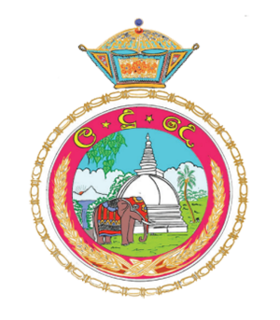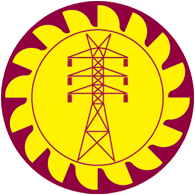Related Research Articles

Colombo is the commercial capital and largest city of Sri Lanka by population. According to the Brookings Institution, Colombo metropolitan area has a population of 5.6 million, and 752,993 in the city proper. It is the financial centre of the island and a tourist destination. It is located on the west coast of the island and adjacent to the Greater Colombo area which includes Sri Jayawardenepura Kotte, the legislative capital of Sri Lanka and Dehiwala-Mount Lavinia. Colombo is often referred to as the capital since Sri Jayawardenepura Kotte is within the urban area of, and a suburb of, Colombo. It is also the administrative capital of the Western Province and the district capital of Colombo District. Colombo is a busy and vibrant place with a mixture of modern life and colonial buildings and ruins.

The Sri Lanka Railway Department is Sri Lanka's railway owner and primary operator. As part of the Sri Lankan government, it is overseen by the Ministry of Transport. Founded in 1858 as the Ceylon Government Railway, it operates the nation's rail and links the capital, Colombo, with other population centres and tourist destinations.

The Ceylon Electricity Board - CEB, is the largest electricity company in Sri Lanka. With a market share of nearly 100%, it controls all major functions of electricity generation, transmission, distribution and retailing in Sri Lanka. It is one of the only two on-grid electricity companies in the country; the other being Lanka Electricity Company (LECO). The company earned approximately LKR 204.7 billion in 2014, with a total of nearly 5.42 million consumer accounts. It is a government owned and controlled utility of Sri Lanka that takes care of the general energy facilities of the island. The Ministry of Power and Energy is the responsible ministry above the CEB. Ceylon Electricity Board (CEB), established by an CEB Act No. 17 of 1969, is under legal obligation to develop and maintain an efficient, coordinated and economical system of Electricity supply in accordance with any Licenses issue

The electricity sector in Sri Lanka has a national grid which is primarily powered by hydro power and thermal heat, with sources such as photovoltaics and wind power in early stages of deployment. Although potential sites are being identified, other power sources such as geothermal, nuclear, peat, solar thermal and wave power are not used in the power generation process for the national grid.

NTPC Limited, formerly known as National Thermal Power Corporation Limited, is an Indian Public Sector Undertaking, engaged in the business of generation of electricity and allied activities. It is a company incorporated under the Companies Act 1956 and is promoted by the Government of India. The headquarters of the company is situated at New Delhi. NTPC's core business is generation and sale of electricity to state-owned power distribution companies and State Electricity Boards in India. The company also undertake consultancy and turnkey project contracts that involve engineering, project management, construction management and operation and management of power plants.

Locomotives and trainsets of Sri Lanka Railways consist mostly of diesel locomotives and multiple units. Steam locomotives are no longer used, except on heritage trains, such as the Viceroy Special.
The Kelanitissa Power Station is a state-owned power station located on the south bank of the Kelani River in the northern part of the city of Colombo, Sri Lanka. Commissioned in 1964, it is the first thermal power station built in Sri Lanka, after the country gained independence. The facility has a current gross installed capacity of 360 MW, a significant amount when compared to the total installed capacity of nearly 4,086 MW in the year 2017. The facility is owned and operated by the Ceylon Electricity Board.
The Colombo Port Power Station is a 60-megawatt powership, permanently moored at the Colombo Harbour, in the Western Province of Sri Lanka. After the plant's 15-year license expired in 2015, the Ceylon Electricity Board purchased the powership in a controversial deal. It was previously owned by Colombo Power Private Limited, a 50-50 joint venture by Mitsui Engineering & Shipbuilding and Kawasho Corporation.
The Sapugaskanda is a 160 megawatt power station located in Sapugaskanda, adjacent to the Sapugaskanda Oil Refinery, in the Western Province of Sri Lanka. The power station consists of twelve generating units, supplied by MAN, and Siemens. Four of the units are rated at 20 MW, while the remaining eight are rated at 10 MW. The power station is operated by the Ceylon Electricity Board.
The Ace Embilipitiya Power Station is a 100 MW thermal power station in Embilipitiya, Sri Lanka. The heavy fuel oil-run power station was commissioned in March 2005, and was operated by Aitken Spence. The power station consisted of fourteen Caterpillar 16CM32C generation units of 7.11 MW each, which consumed approximately 550 tonnes of fuel oil per day. The Ministry of Power and Energy discontinued purchasing power from the private power station after its license expired in 2015, and hence was subsequently decommissioned.
The Uthuru Janani Power Station is a 24-megawatt thermal power station commissioned on 1 January 2013, in Chunnakam, Sri Lanka. The power station consists of three diesel-run generating units with a capacity of 8 MW each, producing 176 GWh annually. Built and operated by the Ceylon Electricity Board for Rs. 3.5 billion, the power station costs Rs. 17.86 to generate one unit of electricity.
The Kankesanthurai Power Station was a fuel oil-run thermal power station which was commissioned as part of the urgent plan by the Ceylon Electricity Board to overcome the 1990s power crisis. Construction of the power station began in August 1998, and the power station was commissioned three months later on 4 November 1998 in Kankesanthurai, in the Jaffna Peninsula of Sri Lanka. It was the biggest power station in the Jaffna region, at that time.
Chunnakam Power Station was a thermal power station in Chunnakam in northern Sri Lanka. Commissioned in 1958, the station is owned and operated by the state-owned Ceylon Electricity Board (CEB). It was decommissioned in 2013, and replaced by the Uthuru Janani Power Station, which is constructed less than 100m south of the Chunnakam Power Station.
The Ace Matara Power Station is a 25-megawatt power station located in Matara, Sri Lanka. During its operations from 2002–2012, the plant utilized four 6.3 MWWärtsilä 18V32LN generating units. The plant was decommissioned in 2012 after its 10-year PPA expired and recommissioned in 2017.
The Ace Horana Power Station was a 25-megawatt thermal power station in Horana, Sri Lanka. The plant operated from 2002-2012 similar to that of the Ace Matara Power Station, and utilized four 6.3 MWWärtsilä 18V32LN generating units. The plant was decommissioned in 2012 after its 10-year PPA expired. The power station was originally planned to be built in Anuradhapura, but was later changed to Horana due to environmental and religious protests.
The Aitken Spence Power Station is a municipal solid waste-fired thermal power station currently under construction at Muthurajawela, Sri Lanka. It was originally planned to be built at Meethotamulla, the site of a large solid waste landfill which was under international media spotlight after the 2017 Meethotamulla garbage landslide which killed over 30 people. The power station will operate approximately 7500 hours a year, utilizing the 700 metric tons (1,500,000 lb) of fresh waste from the Colombo Municipal Council area, daily. The power station in being built together with the KCHT Power Station.

The Sapugaskanda Refinery is the single largest oil refinery of Sri Lanka. The refinery was built by Iran under the guidance of the Ceylon Petroleum Corporation in August 1969, initially designed to process 38,000 barrels (6,000 m3) per stream day of Iranian Upper Zakum crude oil, and Arabian light crude oil. It was commissioned on 12 October 1969. The facility, which covers an area of 165 acres (67 ha), currently has a capacity of 50,000 barrels (7,900 m3) per stream day.

The Sojitz Kelanitissa Power Station, is privately-owned 172 MW diesel-fired combined cycle power station located in Kelanitissa, in the city of Colombo, Sri Lanka. It is owned by Sojitz Kelanitissa Private Limited, a subsidiary of Sojitz Corporation. The power station is located adjacent to the Kelanitissa Power Station, which is a separate government-owned power station.

Trams existed in Sri Lanka's capital Colombo from 1899 to 1960.
References
- ↑ Patrick, Peebles (2015). Historical Dictionary of Sri Lanka. Lanham, U.S.A.: Rowman & Littlefield. p. 134. ISBN 978-14422-5584-5 . Retrieved 8 March 2020.
- ↑ "Ceylon in Market for Diesel Generator Sets". Foreign Commerce Weekly. 54 (1). Washington, D.C, U.S.A.: United States Department of Commerce. 4 July 1955. p. 11. Retrieved 8 March 2020.
- ↑ Wickremeratne, Vinodh (4 October 2011). "Musings on Colombo". Daily News . Colombo, Sri Lanka. Retrieved 8 March 2020.
- 1 2 3 4 Meier, Peter; Munasinghe, Mohan (1994). Incorporating Environmental Concerns Into Power Sector Decisionmaking: A Case Study of Sri Lanka. Washington, D.C, U.S.A.: World Bank Publications. pp. 19–20. ISBN 0-8213-2746-1 . Retrieved 8 March 2020.
- 1 2 Ceylon Year Book 1957 (PDF). Department of Census and Statistics, Ceylon. p. 184.
- ↑ Ceylon Year Book 1959 (PDF). Department of Census and Statistics, Ceylon. p. 202.
- ↑ "Appraisal Report: Norton Bridge Hydro and Second Grandpass Thermal Power Project, Ceylon" (PDF). Washington, D.C, U.S.A.: International Bank for Reconstruction and Development. 17 April 1961. p. Annex 1. Retrieved 8 March 2020.
- ↑ "Granpass Thermal Power Project, Ceylon" (PDF). Washington, D.C, U.S.A.: International Bank for Reconstruction and Development. 30 June 1958. p. 7. Retrieved 8 March 2020.
- ↑ Ceylon Year Book 1968 (PDF). Department of Census and Statistics, Ceylon. p. 309.
- ↑ "Joint UNDP/World Bank Energy Sector Management Programme: Sri Lanka - Power System Loss Reduction Study" (PDF). Washington, D.C, U.S.A.: United Nations Development Programme/World Bank. July 1983. p. 9. Retrieved 8 March 2020.